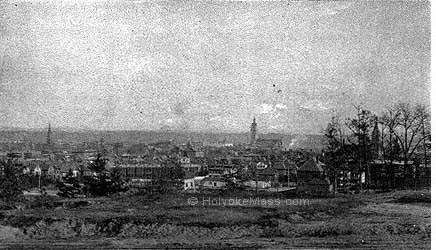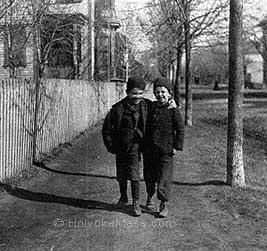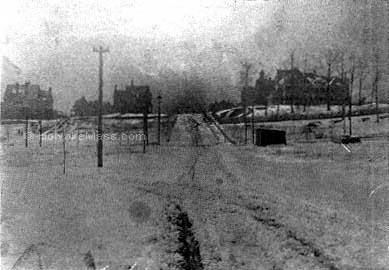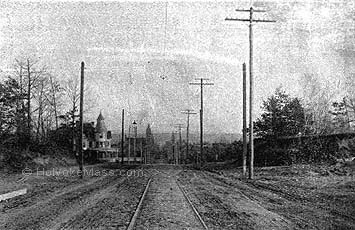"The Paper City" — 1892.
By Clifton Johnson

The City from the Hill.
|
One of the most distinguished of American artists, who had won great fame by his paintings of Indians, was asked not long ago where he intended to go the following season. His reply was, “I’m going to stay right here in New York. I’m tired of the woods and the mountains and plains and streams, where fellow beings are so scattered. I want to be where there is life.” Mr. Howells, the famous novelist, in speaking of his afternoon walks after the day’s work is over says, “I like to go where life is most crowded. I go down into the tenement districts, and I find pleasure in the company of the little street urchins who have such things as dead rats and old cabbage stalks for playthings.” Holyoke is a place of concentrated thronging life, and this simple fact gives it charm, independent of what it has or what it lacks of happiness, culture and comfort.
It is not in the least a question of fine streets or fine houses, or its people being attractive in dress or manner. These things, when we find them, pleasantly touch or sense of harmony; but life itself touches a deeper senseÿthat of sympathy. It may be high or it may be low, prosperous or in adversity, housed in a mansion or dwelling in a crowded tenement; there is a fellow feeling awakened, whatever the surrounding conditions. In one of Robert Burns’ most famous poems there is a frequent recurrence of the line, “A man’s a man for a’ that.” His point is that a bronzed face and rough hands and dirty work and humble housing are no measure of a man’s worth. To the honest worker, whatever his calling or outward appearance, is due a cordial respect. A spirited continuation of the poem referred to has been written in recent years by Charles Mackay. Through it runs the same refrain, but with a new application.

Chums.
|
Its purpose is to counteract a tendency there is in some quarters to condemn the rich simply because they are rich. But a man is not his fine clothes or his fine house. Character lies deeper than that. Wealth need not make one effeminate or overbearing. Poverty need not carry with ir coarseness or ignorance. If a man shows the right metal, high or low, "A man’s a man for a’ that."
Holyoke, like any other city, is made up of rich and poor. The home regions of neither class lack interest, and we should feel it a distinct loss to the truth and attractiveness of the book to neglect either. As we walk about the city, then, we shall take a varied course and follow both highways and byways.
The center of the place seems plainly to be the City Hall. It is a massive structure of granite, with a tall handsomely proportioned tower in front, from whose base a broad terrace of steps leads down into the street. The land itself here rises into a hill, and helps to give the building prominence, no matter whence it is viewed.
To the sight-seer it is supposed to be both a duty and a privilege to climb the steps to the top of the tower to get a bird’s-eye view of the surrounding landscape. He is not at liberty to wander at will up this winding stair, but first get a key from one of the clerks on the lower floor to undo a door which blocks the way two flights up. Once past that door you have left the confines of civilization, and the way becomes at once mysterious and strange. You go up a narrow stair in almost complete darkness, and then cross a landing and go up other flights, and across rough floorings, where above is a rude criss-crossing of unfinished beams in the glooms, and in one place jump down from one floor raised above that beyond and stoop to pass beneath an iron girder stretching from wall to wall. It is a curious place, and contrasts oddly with the impression one gets from without. The rough stones and plaster show in the walls; flooring and timbers and stairways seem placed at haphazard, and nowhere in there is a sign of paint or finish. You can fancy there are bats and such creatures lurking away in the shadows somewhere, One pauses with interest to see the works of the great clock, suspended against the wall behind a glass casing, and to watch the slow swaying of the ponderous pendulum. Then you come out into the more open space, where the big bell is, and if you happen to be there at the striking of the hour, are caught with startled fright, its sound is so loud and near. Here are high, narrow openings through the granite, and you may look deep down into the streets, with their pigmy travel and traffic, or far off over the roof tops. Easterly, the wide lain is filled with blocks of brick and great mills, interwoven with the waterways of the canals. To the west are gradually rising hills, where the homes of the people rise, street after street, to the pasture ridges at the horizon, and all enveloped and half concealed by the foliage of the thick starting trees. But the most striking view is northerly, where the river lies in a basin like a blue lake, and beyond rise Mt. Tom’s bold cliff and more gently in the distance the long range of Mt. Holyoke.
Within the tower, the timbers and exposed boards were covered with the penciled or knife-carved names of visitors. I deciphered a number of these, but so far as I read came upon no one of special distinction in the world. But if some of these put the same effort and ingenuity into their every-day work that they did here to get their names into the most difficult and out-of-the-way places, they are bound to win distinguished success sometime. Going down is a much easier task than climbing up, and once out of the close, hot glooms above and in the cool corridors of the lower building, you feel the experience has been a very interesting sort of adventure.

A Day of Snow-Squalls—Linden Street.
|

Looking Down Appleton Street.
|
© Laurel O’Donnell 1996 - 2006, all rights reserved
This document may be downloaded for personal non-commercial use only
and may not be reproduced or distributed without permission in any format.
This is an edited adaptation from the original publication.
|